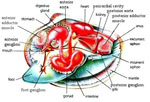Calvert County Fossils
The faunas of the Miocene Calvert Cliffs in Maryland are known
for their rich fossil diversity which includes representatives of all
known animal phyla that have hard parts capable of fossilization.
The most recent surveys estimate that the cliffs hold over 624 species
of organisms, with 214 of these species belonging to the gastropods
(snails), and 187 species belonging to the bivalves (or the
clams). For this study we will be examining the body fossils of
two genre of mollusks, Astarte and Anadara.
Astarte and Anadara are identified as bivalve mollusks (clams), that have
bodies that are divided into 2 main regions, a head-foot
and a mantle (including shell, mantle cavity, and visceral
mass). In bivalves, the muscular foot is the locomotion organ, used
for motion, to attach to hard surfaces, or to burrow into the
substrate. Some bivalve genera display sense
organs (e.g., tentacles and eyes) on their head, while all members of
the Class use the head as the location of their nerve ganglia.
The mantle lines the shell internally; its external edge is the site
of
shell deposition and growth.. The space between the head-foot and the mantle
proper
is the mantle cavity, where the anus and external genitalia are located.

 Back
| Home | Next
Back
| Home | Next
Bivalve Shell
Morphology
Bivalve Internal Anatomy

 Back
| Home | Next
Back
| Home | Next